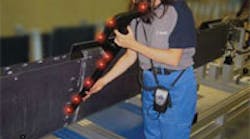SAAB Aerostructures continues to win supply contracts for its composite parts from aircraft builders like Airbus and Boeing orders, notwithstanding the high materials costs, and the high manufacturing costs in Sweden, where SAAB is headquartered. One effective cost-saving advantage for SAAB is a portable measurement system, supplied by Metronor (www.metronor.com), a supplier of electro-optical portable coordinate measuring systems headquartered in Norway.
Large, tight-tolerance composite parts present manufacturing difficulties because of their scale, and because of variations that develop during autoclave curing. Maintaining precise process controls is a challenge. Producing tooling for these parts is a complex process, and expensive even when successful, because the tooling must be able to compensate for inherent process variations.
For example, SAAB Aerostructures supplies Airbus with aircraft rudders that are designed so that both sides are positioned within the airflow. It is critical for the rudders’ hinges to be positioned precisely relative to both surfaces, so that the drill template fits accurately to both surfaces. Achieving this accuracy with tooling is very difficult, and achieving traceability and process stability can be virtually impossible, according to SAAB’s Richard Lindqvist. Metronor supplied to SAAB with a system it callls “strikingly simple.” It features a dedicated production cell where the only fixed tooling is a “re-settable” fixture that holds the entire rudder in a stable position. The drill templates are separate bits of tooling, and are not mechanically connected with the holding fixture. Lindqvist explains: “The precision in this cell does not come from expensive tooling, but rather from a relatively low-cost portable measurement system from Metronor.”
Metronor’s portable measurement systems are based on electro- optics. Using a wireless hand-held probe, the systems provide data similar to the way a conventional coordinate measuring machine does, but they handle large volumes of data, run on a laptop, and fit in a small rollaway case. The Metronor DUO and SOLO systems are in use by more than 200 customers all over the world – primarily in the aerospace and automotive industries.
“The process is conceptually simple,” Lindqvist explains. “First we measure the as-built geometry of the rudder, which obviously has to be within the specified tolerances. Then, we align to the functionally critical geometries of the rudder to obtain a best-fit alignment.
“This is done by simply probing the critical entities with the Metronor and applying a constrained best-fit to the measurement results – all built into the system and its software,” continues Lindqvist. “Finally, we use the measurement system to position the drill templates individually into their optimal positions given the exact geometry of this particular rudder. This guarantees that we produce an end product of the best possible fit given the small variations inherent in the materials and processes specified by the integrator – and produce no scrap parts.”
The production cell was developed by SAAB Aerostructures. Throughput is a eight complete rudder shipsets per day for Airbus. And, the same approach is used on parts for Boeing’s Dreamliner program.
Richard Lindqvist concludes: “We think these cells demonstrate that smart manufacturing is just as important as lean manufacturing. Having long experience with Metronor and the many built-in opportunities of their systems, it was simple to bypass the time and expense of very complex tooling. This Metronor-based cell is just one example of how SAAB Aerostructures stays competitive by trying to working smarter.”









